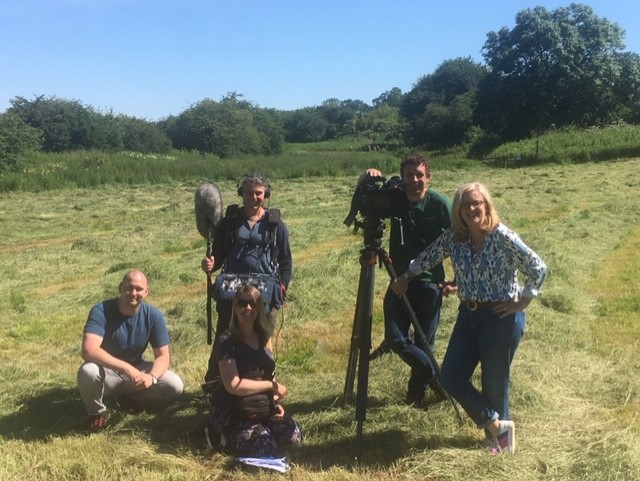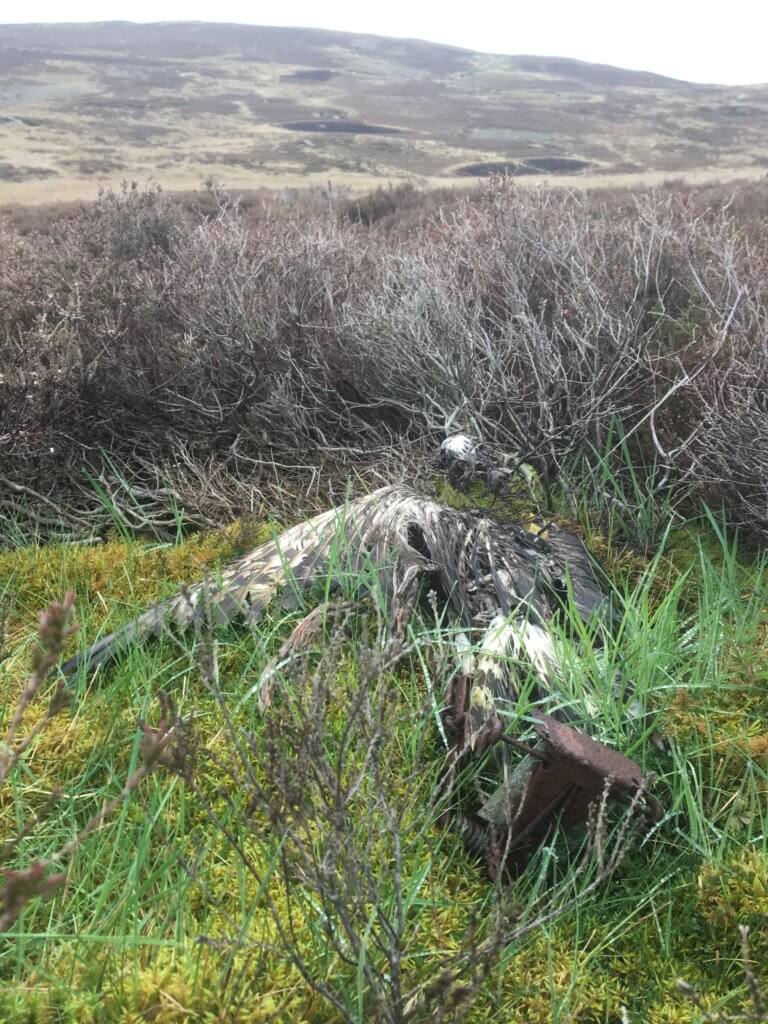
Yesterday I drove up to Wheldrake Ings to have a chat with the Countryfile crew (above, Charlotte Smith on right) about Wild Justice. I was listening to The Jam’s ‘News of the World’ just before I stopped at the Ferrybridge Services and saw this news of a Hen Harrier that died with its leg in an illegal trap on a grouse moor in Strathbraan. Terrible news – just imagine how that bird died.
When I met up with Charlotte Smith et al. there was quite a lot of hanging about, quite a lot of standing in the sun, quite a lot of retakes because small planes kept spoiling the exquisite quality of the interview and quite a few laughs. How it comes over is all in the editing, which is why I so much prefer live pieces, but we’ll all see what it looks and sounds like on Countryfile on 14 July.
It was hot and sunny and there were just loads of Painted Ladies all over the place and a Clouded Yellow flew past too (that looks like quite a northern record).
As I was leaving Wheldrake, and just before I turned on The Jam’s Absolute Beginners, I checked my emails and learned that Natural England, had sneaked out the news that brood meddling of a Hen Harrier nest in England has happened for the first time. The way the news emerged suggests that Natural England is rather sheepish and ashamed about their action.
Yesterday was a day when we were reminded, very graphically, of the illegal persecution facing our raptors and, shamefully, of Natural England’s role in ridding grouse moors of Hen Harriers through licensing an otherwise illegal activity.

What a Modern World where those In the City bring their Eton Rifles to the uplands. I guess you’re now passsed the Start of the campaign to ban DGS, and it will be the Bitterest Pill they have to swallow once their pastime is on the Funeral Pyre
Rob – I see what you did there 😉 Are you a fan of The Jam too?
Indeed, who isn’t?!
Isn’t the situation too serious for silly jokes?
A horrible death for yet another persecuted Hen Harrier and the announcement that NE have done the dirty deed in BMing a nest on a Yorkshire grouse moor.
One had hoped that with TJ in place they just might have seen sense because this scheme cannot and will not deliver more than a token Harrier population in our uplands, a very sad day for harrier conservation. The Jam —- oh dear certainly not for me!
How horrific all this is. I trust the police have been called in regarding the illegal trap and the land owner is being well and truly questioned.
Regarding the BM I had hoped better of Tony Juniper. A pretty poor start to his term of office.
However overall we must always bare in mind that this terrible, terrible Government is behind the BM and is probably not keen to see the perpetrator of the illegal trap caught.
Gosh, with the utter nonsense going on in the Tory Party surely this country cant sink much lower.
Hi Mark –
I know this is going to open up a can of worms but…can I ask why brood management is considered wrong? If it is successful will it not ensure survival of Hen Harriers? This is not a rhetorical question by the way, I genuinely want to understand the views of those against the strategy.
S
S this may be a long and tortuous explanation but try to bear with me. Back in the days when raptor groups were involved with discussions to solve ” the Hen Harrier persecution problem” it was shown using Moorland Association supplied grouse densities that your average grouse moor with average grouse densities (which have considerably increased since) could support two pairs of Hen Harriers per 5000 acres without a noticeable decline in grouse bags, even inserting a huge safety margin of 50% ( so one pair) The grouse lobby in those discussions found this entirely unacceptable , preferring their deeply held prejudices to good science. Incidentally this is 15 to 30 times the density used to trigger BM depending whether you take in the extra safety factor or not ( I wouldn’t, there was leeway enough in the figures).
Remember this is a crime problem, not a conservation problem all down to widespread intolerance and illegal killing of Hen Harriers. Also remember that taking all factors in to account there is enough habitat in ENGLAND for 320-340 pairs of Hen Harriers. At the time of these discussions the grouse lobby proposed “Brood management” without a specific density such that if the entire English population were just two pairs but they were on the same moor they would expect one to be “managed.”
For any of this to happen the conservationist side wanted a considerable reduction in persecution, it is after all illegal to kill harriers or interfere with their nests and has been for at least 65 years. It was argued that we needed this as a sign of genuine good will and even then would probably need a healthy harrier population of say 70 pairs ( 20% of capacity) before we could consider something so unpalatable to us. We also expected the grouse moor owners/shooters to bear ALL the cost of any such scheme, as they are the only beneficiaries.
This all came to nought and the governments Hen Harrier plan was produced without our input, not that it would have effected its current unacceptability. Many of us have always believed BM to be a last possible option in a healthy harrier population where supplementary feeding has not worked.
So our objections are multiple:-1 the density used is far too low
2 We do not have a healthy and relatively unpersecuted population.
3 Supplementary feeding has not been widely trialed
4 The impossibly low density means grouse moor populations will probably not be widespread but will gravitate to known harrier hot spots where most pairs will eventually be managed.
This is without all of our objections to the dangerous precedent this sets for all other protected predators, the lack of persecution reduction, who pays and the very idea of limiting the population of heavily protected native wildlife for the vested interest and profit of very very few of us. Also what other crime problem has been solved by concessions to the criminals?
Then there are the practical considerations, let us consider what happens with even a moderate increase in harriers on grouse moors—– say 30 to 50 pairs, at the current density used for BM that would probably mean 15-25 pairs being subject to BM, and in the unlikely event of continued population growth this would rapidly become impossible to carry out.
Even with rose coloured spectacles on this cannot remotely give us a decent unpersecuted Hen Harrier population, it is to put it simply a sop to the prejudices of grouse managers.
Paul – thanks for doing this – well put!
Paul V I – Thank you, that was very comprehensive and certainly enlightened me on the debate. Much appreciated.
When was the last successful breeding in Yorkshire? In 2011 the annual report of the Yorkshire Naturalists Union described them as extinct as a breeding species so it must be some time ago.
In all that time the grouse shooting industry didn’t want Hen Harriers on the moors. This year they wanted them nesting to provide chicks for this appalling scheme and hey presto! we have had breeding Hen Harriers. We’ve all known that the lack of breeding success is entirely down to the persecution by the estates but they are now proving their guilt by being able to rustle them up on demand.
Where do NE go from here, surely the only way that they could deem it a success is if a population of birds that breed and remain exclusively in the lowlands is established? When birds are lost over pheasant estates, where do they try establish a new population.
We can assume these birds will be tagged, if they make their way into the uplands we know from mortality rates of tagged birds that they are likely to be killed on the estates, so can they repeat this exercise next year? How will they explain away wasting public money on an exercise that is doomed for failure?
The only way that failure could be avoided is if the estates were told the locations of these specific birds and chose not to kill them. Natural England wouldn’t do that, would they?
This is NOT a translocation scheme and such is not on the licence they will be released in the uplands near where they came from. It is purely to reduce the number of grouse chicks taken. They bred in North Yorkshire successfully last year, prior to that the last success was 2007 and nest (s) failed naturally in 2017. Two nests failed in West Yorkshire last year. Harriers are great wanderers telling folk where they are is pointless tomorrow they could be 100 miles away.
Mark, I am sorry disgusted to see this horrible event, and cannot imagine that death. But it is no worse for the individual than the death of any creature in such a trap. I saw pictures online of a young hare miserably suffering in a legal trap on a local grouse moor. What can be done? Farm animals suffering in such a way would bring about prosecutions.
Hilary – I agree. The trap was set illegally but even so…